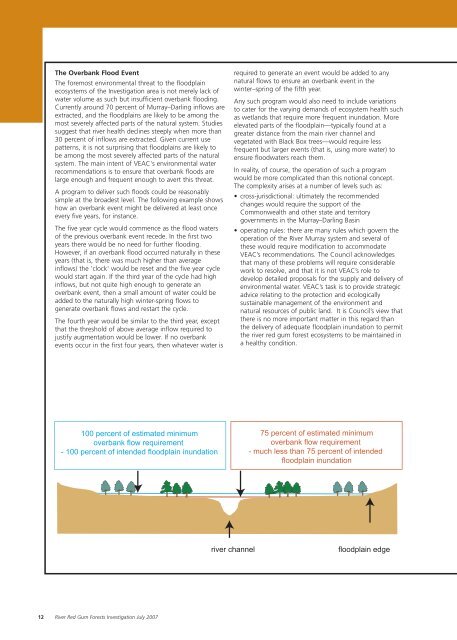Draft Proposals Paper - Full - Victorian Environmental Assessment ...
Draft Proposals Paper - Full - Victorian Environmental Assessment ...
Draft Proposals Paper - Full - Victorian Environmental Assessment ...
You also want an ePaper? Increase the reach of your titles
YUMPU automatically turns print PDFs into web optimized ePapers that Google loves.
The Overbank Flood Event<br />
The foremost environmental threat to the floodplain<br />
ecosystems of the Investigation area is not merely lack of<br />
water volume as such but insufficient overbank flooding.<br />
Currently around 70 percent of Murray–Darling inflows are<br />
extracted, and the floodplains are likely to be among the<br />
most severely affected parts of the natural system. Studies<br />
suggest that river health declines steeply when more than<br />
30 percent of inflows are extracted. Given current use<br />
patterns, it is not surprising that floodplains are likely to<br />
be among the most severely affected parts of the natural<br />
system. The main intent of VEAC's environmental water<br />
recommendations is to ensure that overbank floods are<br />
large enough and frequent enough to avert this threat.<br />
A program to deliver such floods could be reasonably<br />
simple at the broadest level. The following example shows<br />
how an overbank event might be delivered at least once<br />
every five years, for instance.<br />
The five year cycle would commence as the flood waters<br />
of the previous overbank event recede. In the first two<br />
years there would be no need for further flooding.<br />
However, if an overbank flood occurred naturally in these<br />
years (that is, there was much higher than average<br />
inflows) the 'clock' would be reset and the five year cycle<br />
would start again. If the third year of the cycle had high<br />
inflows, but not quite high enough to generate an<br />
overbank event, then a small amount of water could be<br />
added to the naturally high winter-spring flows to<br />
generate overbank flows and restart the cycle.<br />
The fourth year would be similar to the third year, except<br />
that the threshold of above average inflow required to<br />
justify augmentation would be lower. If no overbank<br />
events occur in the first four years, then whatever water is<br />
required to generate an event would be added to any<br />
natural flows to ensure an overbank event in the<br />
winter–spring of the fifth year.<br />
Any such program would also need to include variations<br />
to cater for the varying demands of ecosystem health such<br />
as wetlands that require more frequent inundation. More<br />
elevated parts of the floodplain—typically found at a<br />
greater distance from the main river channel and<br />
vegetated with Black Box trees—would require less<br />
frequent but larger events (that is, using more water) to<br />
ensure floodwaters reach them.<br />
In reality, of course, the operation of such a program<br />
would be more complicated than this notional concept.<br />
The complexity arises at a number of levels such as:<br />
• cross-jurisdictional: ultimately the recommended<br />
changes would require the support of the<br />
Commonwealth and other state and territory<br />
governments in the Murray–Darling Basin<br />
• operating rules: there are many rules which govern the<br />
operation of the River Murray system and several of<br />
these would require modification to accommodate<br />
VEAC’s recommendations. The Council acknowledges<br />
that many of these problems will require considerable<br />
work to resolve, and that it is not VEAC’s role to<br />
develop detailed proposals for the supply and delivery of<br />
environmental water. VEAC’s task is to provide strategic<br />
advice relating to the protection and ecologically<br />
sustainable management of the environment and<br />
natural resources of public land. It is Council’s view that<br />
there is no more important matter in this regard than<br />
the delivery of adequate floodplain inundation to permit<br />
the river red gum forest ecosystems to be maintained in<br />
a healthy condition.<br />
100 percent of estimated minimum<br />
overbank flow requirement<br />
- 100 percent of intended floodplain inundation<br />
75 percent of estimated minimum<br />
overbank flow requirement<br />
- much less than 75 percent of intended<br />
floodplain inundation<br />
river channel<br />
floodplain edge<br />
12 River Red Gum Forests Investigation July 2007
















